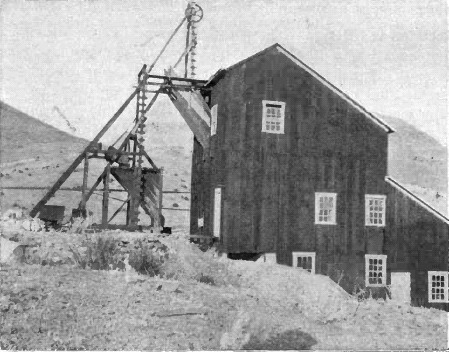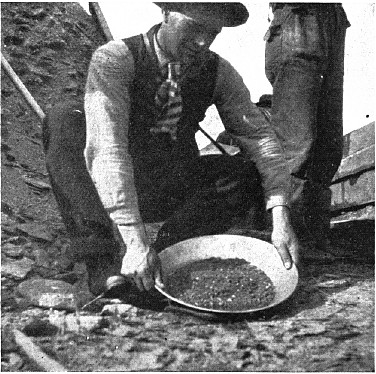CRYSTALLINE IGNEOUS OR
ERUPTIVE ROCKS:
These are rocks which are supposed to have been thoroughly fused or
melted in the bowels of the earth. Some reach the surface by fissures or
volcanic vents, others have never attained to the surface or over flown it,
but have intruded themselves between the weak places in the underlying
strata, or have collected and cooled deep down below the surface in great
molten reservoirs called "laccolites" or lakes of stone. When these have
been subsequently uncovered by erosion, they may present the forms of
considerable mountain masses, like the Elk Mountains, and Henry Mountains
and Spanish Peaks. Geologists distinguish those rocks which have poured out
on the surface from craters and volcanic vents as volcanic rocks, whilst
those cooling below are called Plutonic.
INTRUSIVE PLUTONIC
ROCKS:
The component minerals of these intrusive Plutonic rocks, such as are
commonly called porphyries, are principally quartz and feldspar, with mica
or hornblende. In color these rocks are some shade of grey, green or maroon,
or even white, but their most striking characteristic is a general spotted
appearance. This arises from more or less large, distinct, perfectly formed
crystals of feldspar or quartz, set in a finer grained crystalline paste or
background, standing out distinctly from it. This base or background may be
comparatively coarsely crystalline, finely crystalline, or so finely
crystalline,
that the crystals can be discovered only by a microscope, whilst the larger
crystals seem set in the paste, like plums in a pudding.
In the depths of a mine
the porphyry is commonly much decomposed by water action or mineral
solutions, and even passes into a clay or gouge. The characteristic spotty
appearance, from the presence of individual crystals of feldspar may even
then identify the rock, or by chemical analysis the very aluminous character
of the decomposed rock may determine its character. When feldspar is the
main constituent, it is called a felsite porphyry, when a certain amount of
quartz is present a quartz porphyry.
DIORITE, whose crystals are sometimes porphyritic in character, hence
called porphyritic diorite or porphyrite, belongs also to this intrusive or
Plutonian class, differing only from the others in the fact that its
feldspar is of the triclinic plagioclase kind rather than orthoclase.
Hornblende is a prominent constituent of this rock, and gives it, more or
less, its dark, olive green tint. In appearance it resembles a dark syenite,
but its occurrence as an eruptive, intrusive rock distinguishes it, as
syenite is generally a metamorphic rock. The peaks of the Elk Mountains are,
many of them, of diorite. Diorite or porphyrite is the so-called porphyry of
Aspen, above the ore deposits.
QUARTZ PORPHYRIES:
These are the commonest, and may be said to be the prevailing eruptive
rocks associated with our ore deposits in Colorado, as for instance at
Leadville, felsite porphyries as well as quartz porphyries occur in the
granite rocks in the Central and Georgetown mining districts. All these
rocks are common through the West, and quartz porphyries are the most common
eruptive rocks the prospector is likely to meet with in his search for ore
deposits. We will describe in detail one or two typical species, though it
must be observed that these porphyries are of endless varieties and shades
of appearance.
QUARTZ PORPHYRY. A quartz porphyry is a porphyry that contains quartz
crystals, large or small, in addition usually to large orthoclase feldspar
crystals, generally of a vitreous glassy variety called "sanidine," together
with small crystals of hornblende or mica. As a typical example we take that
which forms the dyke composing the peak of Mt. Lincoln, Colorado, called Mt.
Lincoln quartz porphyry. This porphyry and varieties of it are common in the
western mining sections of Colorado. In appearance it is a gray rock spotted
with large and small crystals of orthoclase sanidine feldspar, which
sometimes show an oblong face two inches long, by an inch wide, at other
times a shape like the gable end of a house, according to whichever part of
the crystal happens to be exposed. Sometimes two crystals are seen locked
together, forming what are called Carlsbad twins. When the rock is
decomposed, these crystals not infrequently drop out and lie as pebbles on
the ground. With these may be also seen rounded ends of bluish crystals like
broken glass. These are portions of perfect quartz crystals, which when
extracted show a six-sided pyramid at either end. These larger crystals are
set in a crystalline ground mass of much smaller crystals of the same kind,
together with many little black cubes of shining mica, or duller lustred,
longer, rectangular, oblong crystals of hornblende. This porphyry is
eruptive and intrusive, occurring in dykes, intrusive sheets and laccolites.
VOLCANIC ROCKS:
These intrusive plutonic porphyries and diorites are generally older
than the other class which reached the surface and poured over it and which
may be called for distinction "effusive' volcanic rocks. Typical of these we
may cite the dark basalts and dolerites that often cap the table lands of
the prairie region and overlie our coal beds. A pinkish or dove-colored
rhyolite also caps some of the mesas and in certain districts an andesite
lava.
DOLERITE AND BASALT.
The latter being scarcely more than a fine grained variety of the former,
are very dark rocks, consisting of dark, heavy minerals, such as augite,
magnetite and a plagioclase feldspar called labradorite. Such
minerals are said to be basic, and the rock composing them also basic.
ANDESITE is very like dolerite, though generally a lighter gray or
pink. Both augite and hornblende may occur in it, more especially
hornblende, sometimes mica also. The feldspar is called andesite feldspar
from the Andes Mountains.
RHYOLITE, under the microscope, shows a peculiar flowing structure,
hence its name from "rheo" to flow. The lighter rocks in Colorado and the
West are generally rhyolites rather than true trachytes. Their colors are
pale gray, white, pink or sometimes dark. Rhyolite consists of a fluent,
vitreous, ground mass or paste, usually containing crystals of sanidin
feldspar, or even of
quartz. When these crystals are conspicuous so as to give the
rocks a porphyritic appearance it is called "liparite." In some cases it may
have even a granite-like appearance, the crystals' of quartz, mica and
feldspar being more or less intermixed; then it is called Nevadite. It is an
acidic rock consisting of acid minerals mainly.
TRACHYTE, from " trachus" rough, is a light colored rock, with a
peculiar characteristic rough feel, due to microscopic vesicularity. It
consists of a ground mass of sanidine feldspar and augite, containing
crystals of the latter. In ninety nine cases out of a hundred in Colorado at
least, also in the Western US, rocks which are popularly called "Trachytes"
are rhyolites or porphyries.
BASALT and some of the other extrusive volcanic rocks assume a
columnar form on cooling. Also, on the surface of the flow, the lava becomes
minutely honey-combed like sponge, from escape of steam. This is called
scoria and when these holes are filled with almond-shaped white crystals,
amygdaloid. At other times the rock is a volcanic breccia ; that is, angular
blocks of lava, great or small, are cemented together by lava. This probably
was caused when the lava was pouring out of the fissure slowly, some
portions congealed and were broken up by the onward flow, and again involved
in the molten mass without being remelted. Enormous masses of volcanic
breccia cover the San Juan region. Sometimes, by steam, the lava is blown
into dust and descending with water, is worked up into a volcanic sandstone
known as volcanic "tufa" or "tuff."
OBSIDIAN is vitrified lava or volcanic glass.
Continue on to:
Examining And Evaluating Mining Properties
Return To:
Gold And Silver Basic Prospecting Methods


